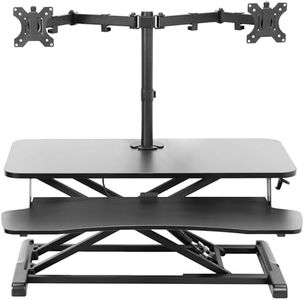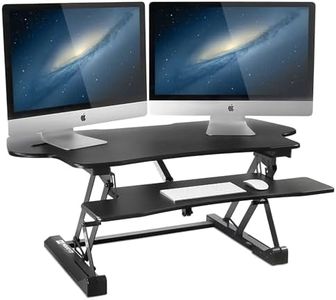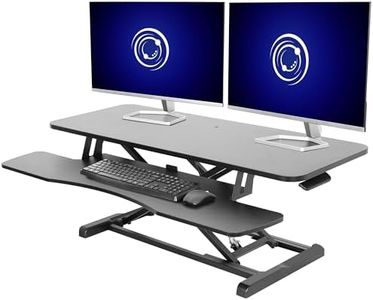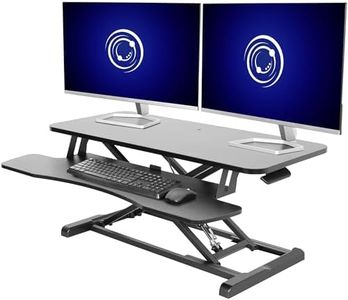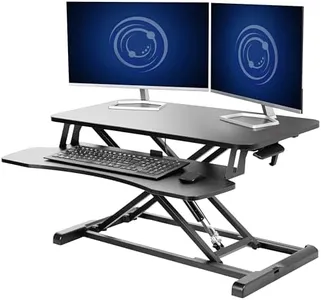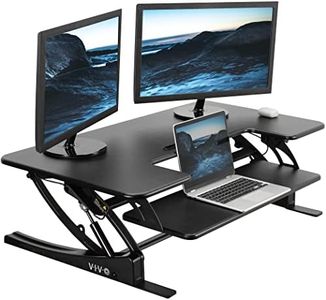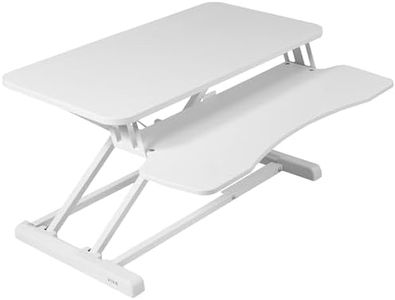We Use CookiesWe use cookies to enhance the security, performance,
functionality and for analytical and promotional activities. By continuing to browse this site you
are agreeing to our privacy policy
10 Best Sit Stand Desk Converters
From leading brands and best sellers available on the web.Buying Guide for the Best Sit Stand Desk Converters
Sit-stand desk converters are useful tools that allow you to change between sitting and standing while working at your desk, making your workspace more flexible and healthier. When choosing the right sit-stand desk converter, it's important to consider several main features to ensure that it fits your existing desk, supports your equipment, and helps you work comfortably. Think about how you'll use the converter throughout your workday and what will make the switch between sitting and standing easy and convenient for you.Weight CapacityWeight capacity refers to the maximum weight that the converter can safely support. This is important because you want your screens, keyboard, and any other desk items to be stable and safe. Weight limits are often grouped into light duty (up to 15 kg), medium duty (15-22 kg), and heavy duty (over 22 kg). If you use just a laptop or a lightweight monitor, a light duty model is usually enough, but if you have multiple monitors or like to keep a lot on your desk, you’ll want a medium or heavy duty converter. Always check what you plan to put on the converter and choose accordingly for safety and stability.
Height Adjustment RangeHeight adjustment range shows how high or low you can set the converter. This is important because it affects how comfortably you can work while standing or sitting. Some converters only lift a small amount, while others go much higher to suit taller users. Generally, a range of 30-50 cm is enough for most people. If you are tall, or if your current desk is low, look for a model with a higher maximum lift. Make sure the converter’s range matches your height so that you can keep your screen at eye level and your desk at elbow height for comfort.
Work Surface SizeWork surface size describes how much space you have on top of the converter for your devices and other items. A larger surface lets you fit dual monitors or extra paperwork, while smaller ones are more compact and suitable for tight spaces. Work surfaces often range from about 60 cm to over 120 cm wide. Consider the monitors, keyboard, mouse, and other essentials you need on your desk; if you use more equipment, pick a bigger surface, but if you work with just a laptop and enjoy a tidy desk, a smaller one could be ideal.
Adjustment MechanismAdjustment mechanism refers to how you move the converter up and down, such as manual lifting, assisted with springs or gas, or electric controls. This matters because you want to switch easily between sitting and standing, especially if you change positions often. Manual converters are simple and cost-effective but can need more effort, whereas gas spring or electric models are smoother and easier, especially with heavier setups. If you have limited strength or change heights frequently, a gas spring or electric model will make your workday smoother.
StabilityStability means how steady the converter is when you are typing or moving equipment. A wobbly desk converter can be distracting and uncomfortable, especially when typing or using a mouse. Stability depends on the frame design and construction quality. Wider, heavier bases and strong materials usually provide more stability. If you do a lot of typing or have a heavy setup, pay extra attention to reviews or details that mention stability. Choose a stable converter to keep your work safe and comfortable.
Keyboard TrayKeyboard tray is the lower shelf on some converters where you can place your keyboard and mouse. This tray helps keep your hands at a comfortable height for typing. Some models have fixed trays, while others are adjustable or removable. If you type a lot or need an ergonomic setup, look for a converter with a spacious, adjustable tray. If you use only a laptop, the tray might not be as important for you.
